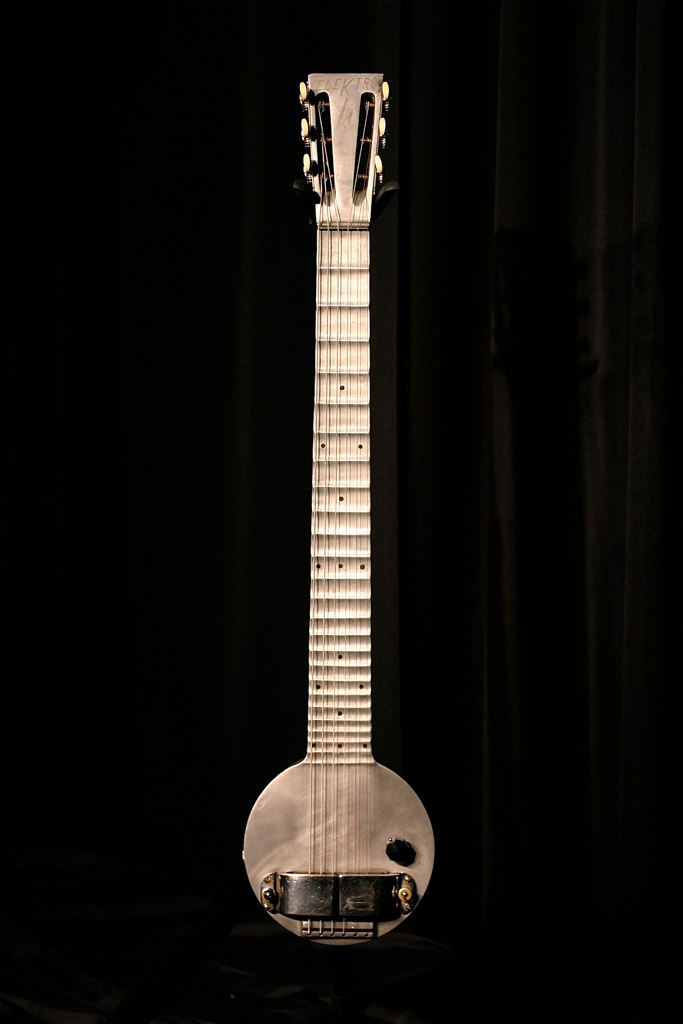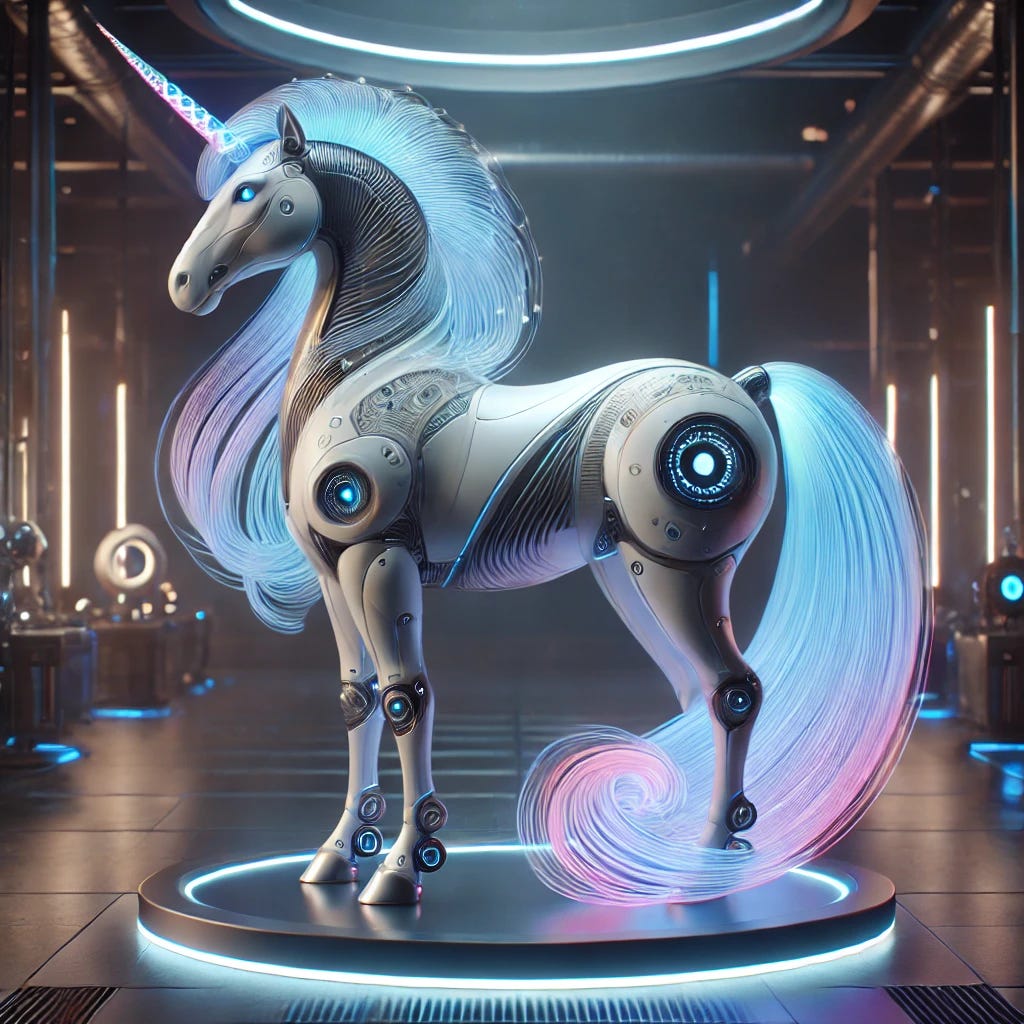The NeurIPs convention brought 16,000 AI people to Vancouver last week, including Ted Chiang, the famous science fiction author and author of the article in the New Yorker that caused so much stir in August because he wrote that AI can’t create art. I had the chance to hear him speak and I have to say that although the man is obviously a god from the sci-fi side of things, I didn’t agree with anything he said except that “if you want more art in the world, ask your government to fund … universal healthcare." In his talk he put forward the same argument as in the article, but extended a few points as well.
The first electrically amplified stringed instrument to be marketed commercially was a cast aluminium lap steel guitar nicknamed the "Frying Pan" designed in 1931 by George Beauchamp, the general manager of the National Stringed Instrument Corporation, with Paul Barth, who was vice president. By Museum of Making Music at English Wikipedia, CC BY 3.0, https://commons.wikimedia.org/w/index.php?curid=9813973
His view is that AI can’t create art because it can’t make the many zillion choices that an artist makes when creating art. By choices he means the deliberate decisions of a creative, expressive creature, that AI can’t do because it deploys pattern recognition on a huge body of stolen work. In the article he seemed to accept that artists can use AI as a tool, but in the talk he was pretty aggressively against any interaction with AI.
I think the choices thing is kind of interesting because I can see why he says that. He is primarily a writer and so I think he means that an author chooses every single word deliberately, and that a great story can be a crappy book if it is written badly because no one focused on the actual words. Fair.
But it made me think about how visual artistic production that uses Generative AI is actually deeply rooted in choices - weirdly that this might in some ways be one of the things that characterizes it in relation to many other kinds of media. A while back there was chatter about how - if AI introduces new aspects of creative production or new modalities for the artist to operate - then it might be that the artist becomes more like a curator or art director because there is so much chance-based interplay and a need to discard many suggestions. Others have observed that working with AI is like working with a drunk studio assistant. So there’s that.
But I was also kind of amazed because Chiang seems to be working from a super arcane modernist ‘solitary genius in the attic’ vision of what art is and what it is to create art. He clearly thinks of art as a static two dimensional thing. None of this relational, contextual, historical intentionality. Enough with the social-cultural, political field of gestures, this imaginative, ambiguous exploration of materiality or technology. Out with the social critique, the contemporary moment. Cut the collaborative crazy talk. Media? Forget it. Art is a picture.
I think he believes that his position is controversial because people "on side” with AI want to press a button and get a unicorn that is art. Literally no one believes that or ever said that. (Clip art, maybe?)
So if he’s working from that position, the rest could follow, though I find it quite muddled. He says:
That the material in the training set is stolen. Ok but that is a different point.
That artists won’t get paid because of the button thing. See above.
That real artists don’t create work in order to be paid. Well which is it?
That OpenAI and other companies have commercialized Generative AI. Yes.
That since AI can accelerate processes of creation, it is offering a ‘force multiplier’, and anything that is used to speed up creation processes means that the creator is ONLY interested in speeding it up, meaning that the output is by definition, shit. Computer much?
He was also a little weird about electric guitars. My interpretation of what he said was that just as electric guitars can amplify and modify the sound produced by a musician but cannot create music independently, AI can assist artists in their creative processes but cannot originate genuine art on its own. But this is wondrous. No one ever said AI is making art on its own. Except those people who built AI-da (“the world’s first ultra-realistic robot artist”) and somehow got a million dollars at auction for a painting of Alan Turing. I’ve spoken to those guys (Hi Aiden & Lucy!) and am 100% in the camp that it’s not that the AI robot is an artist, it’s that if anyone is the artist it’s Aiden and Lucy, and the robot is the artwork. (FYI they don’t like this reading.)
Prompt: a unicorn companion for the world's first ultra-realistic robot artist
Further, Chiang said that maybe - just maaaaaybe - way way down the line there could be something in the generative AI world that might just a little bit function like an electric guitar in the sense that it would create entirely new vistas of artistic production. But dude - that is what we have now. Once again for those in the back - AI is a medium.







Wouldn’t AI (in its multitude incarnations) be a tool(set) and not a medium? But maybe I’m being overly semantic. Maybe you mean medium like, working with watercolours.
I definitely think that it has been clearly demonstrated that (great) art can be made with generative tools. And that it seems radically reductive to even argue about whether “AI is art” since those words don’t really mean anything.
What’s interesting to examine for sure are the multiple times/places where art “happens”. Is it in the making or the experience? Does the artist make it art or the viewer?
Seeing the world as aesthetic—in all its forms—invites gratitude for how existence unfolds as an integrated tapestry. It’s reminiscent of the idea that consciousness, in various guises, is the universe beholding itself from within.
The notion of “the network seeing itself as network” underscores a self-reflective awareness: the parts are never merely isolated, but rather indices of an all-encompassing whole. Recursive/Inference. In a sense, the observer and the observed collapse into a single interplay of mutual recognition, much like Indra’s Net in Buddhist or Hindu cosmology—each jewel in the net reflects every other jewel.
From an aesthetic or phenomenological standpoint, this means there’s an inherent poetry or significance in all phenomena simply by virtue of being. The color of a flower or the resonance of a sound, the logic of a rock dreaming of a cloud—these aren’t merely inert data points; they’re portals to the wonder of existence itself.
When we let this perspective infuse our encounter with AI-generated art (or any art), we see more than mechanistic outputs. We see how the “network” of training images, algorithms, prompts, and human imagination can become a mirror in which existence contemplates its own aesthetic possibilities. It’s an infinitely recursive reflection: the world recognizing its own world-ness—singularity appreciating its own singular occurrence.
We are the ancients. The inheritors of the most earliest mark makers. AI is the cipher. Nature itself operates as a grand cipher. The growth of a tree, the migration of birds, or the rhythm of planetary systems—these are encoded patterns, vast and intricate, waiting to be deciphered. AI, as an interpreter, extends our capacity to read these natural codes. It deciphers the undeciphered, mapping connections that were previously invisible to human perception.
However, this decoding is not passive. AI’s role as an interpreter is shaped by the frameworks we impose—our questions, biases, and intentions. In this way, the act of decoding becomes collaborative. The cipher’s key evolves, reflecting our collective inquiry into the unknown. What emerges is not merely a set of answers but a dynamic dialogue between human and machine, known and unknown. Here art is an expression of the unknown, of revelation, of relationship.